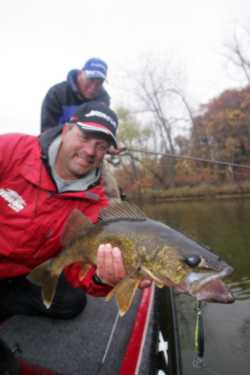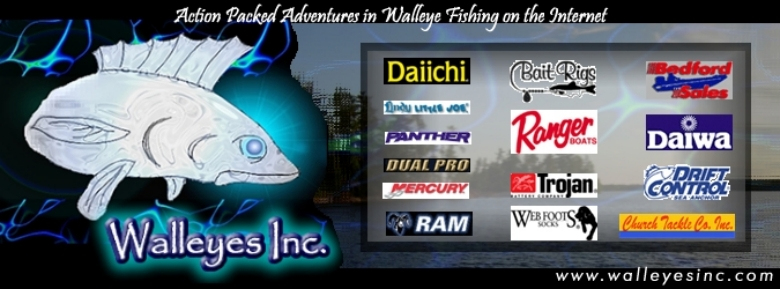| Editor's note: John Kolinski is the 2002 Professional Walleye
Trail Angler of the Year, the 2003 Illinois River RCL winner
and a 17-time championship qualifier. He is the only anger to
fish the PWT and B.A.S.S. at the same time. His articles can
be read in numerous Midwestern outdoor publications and at several
web sites. Kolinski is sponsored by Triton Boats, Mercury Motors,
Lowrance Electronics, Yo-Zuri fishing line, Normark/Storm Lures,
MinnKota, Lindy Legendary Tackle, Tempress Rod Holders, Off-Shore
Planer Boards, Optima Batteries and Panther Marine. |
For a teen-ager, acquiring a driver's license is a defining
moment in life. It represents independence, responsibility and
a degree of freedom that didn't exist when travel was limited
to bicycles and tennis shoes.
That doesn't mean our sense of adventure was repressed throughout
our youth. Thinking back, there were places we went and things
we did that we will never forget.
For those of us who have grown up to become avid anglers, owning
a boat is akin to a new lease on our fishing life. It opens
up a world of destinations and opportunities that we previously
only heard and dreamed about.
But again, that doesn't mean we weren't able to pursue our passion
for fishing during our landlocked days. We found places to fish
from shore or by wading that helped hone our angling skills
and instilled a degree of fishing knowledge that lasts a lifetime.
I learned to cast jigs over rocky structure. I began to understand
the subleties of buoyancy and profile in a presentation. I learned
how to read current during my early years fishing from the banks
of local lakes and rivers. I learned how to use three-way rigs
and how to fish a slip bobber, along with dozens of other skills
that have served me well as a professional angler.
 |
Actually, some of the best angling of the
year occurs close to shore in the spring of the year.
Many species of fish, including walleye, northern pike,
bass, catfish, crappies and bluegills can be found in
or near shallow water, often in places boats simply can't
reach.
It's a great time of year to keep a rod and reel combo
and a handful of lures in the car or truck for those quick
stops on the way to work, during a lunch break or on the
way home.
It's grass-roots fishing, plain and simple, and also a
great way to spend quality time with the family or introduce
new anglers to the sport. Turn it into a fishing picnic.
Take the dog along for some exercise. Set up a couple
of dead rods and play catch with the kids. Dig around
in the shallows or move a few rocks and you'll unearth
an educational experience in aquatic biology.
It always brings a smile to my face when I pass close
by shore in my Triton 215X and get a big wave from a happy
young angler. On the other hand, there are times when
I'm competing in a big tournament and that smile turns
to a frown when a shore angler lifts a heavy stringer
from the water and I'm still trying to catch my first
fish. |
Here's a basic guide to shore fishing:
WHEN TO GO
Fish whenever you can, but keep in mind that May and early June
are times of the year when a variety of species are close to
shore.
Some fish, like walleyes and northern pike, are there in the
spring to forage after completing their spawning ritual. Crappies
spawn a little later than walleyes and northerns, but they'll
be feeding shallow in preparation for procreation or staging
for the spawn.
Bluegills and bass spawn even a bit later, so their interest
in the shallows is largely food-related. It's a place they can
find variety with everything from grubs and salamanders to minnows
and aquatic insects.
Because you are fishing shallow water, light penetration is
a consideration. Most species of fish don't like direct sunlight,
so they'll visit the shallows most often during low-light periods
or on overcast days, unless there is enough color in the water
to knock down the sun's rays and provide a sense of security.
WHERE TO GO
Rivers, lakes, reservoirs, borrow pits and ponds are all good
choices. A lot depends on what species you want to pursue, what's
close to home in your area and what's accessible from shore.
More and more of our natural lakes offer limited access because
of lakeshore development by private interests. However, in many
states it is legal to fish anywhere you can reach by water,
so if you can find an access point, you can wade the shoreline
anywhere you want to fish.
Private ponds are a great place to shore fish. Many are home
to slab crappies and big bluegills, not to mention some killer
bass, and most landowners will grant permission to responsible
anglers.
In general, there is much easier shoreline access to rivers,
public lakes and most reservoir systems.
The beaten path can be a good thing in these areas. First, look
for parking areas. Then follow the trails leading from them
to the water. There are plenty of savvy shore anglers out there
who know where the best spots on a lake or river exist and their
trails through the grass or woods will lead you there.
In general, crappie anglers should look at the northern reaches
of the smaller lakes first. That's where the water typically
warms fastest and where the first ice-out bites usually occur.
Find a shallow bay or slough with some rock and you will likely
find aggressive crappies.
There have been many occasions in early and mid-May when I've
enjoyed some spectacular crappie fishing in the shallow lakes,
canals and drainages connected to larger lakes with decent crappie
populations. At the same time, I've hooked up with some bruiser
bass.
If your passion is walleyes, river systems are a great place
to target because those post-spawn fish will be feeding heavily
as they work their way toward their summer hangouts. The easiest
place for a hungry walleye to ambush its prey is in shallow,
murky water. Walleyes and northern pike are also attracted to
shoreline areas because they provide sanctuary from the current.
Lakes and reservoirs of all sizes provide a good spring walleye
bite for shore anglers, too. If a body of water has a decent
walleye population, you can likely target them from shore.
WHAT TO LOOK FOR
Vegetation attracts forage, which attracts gamefish on most
of our lakes and reservoirs.
A good place to find walleyes on these bodies of water is anywhere
a creek or slough empties into the lake. Many walleyes travel
up these narrow passages to spawn, and what goes up must come
down. May is a good time to catch them on their return trip.
If areas like that aren't present or aren't accessible, other
early season spots to target are flats with vegetation. Because
light penetration isn't as big a factor in May and because food
and oxygen are abundant in these areas, walleyes, bass, pike
and even perch love them and will use them extensively.
And because weed growth is only beginning to take root, these
areas are also more fishable at this time of year than any other.
Inside corners on river systems hold fish like walleyes and
catfish. If the current is fast, look for eddies and current
breaks where fish can escape the flow and ambush prey without
expending a lot of energy.
Fallen trees and stumps along the shorelines are also river
hotspots. They provide a variety of food and can serve as current
breaks.
Creek arms or sloughs off the main channel are great places
to look for largemouth bass. Rocky shorelines attract smallmouth
bass, white bass and, at certain times of the year, crappies.
Many man-made lakes, and even some natural bodies of water,
do what they can to cater to shore anglers, too, by building
jetties that are natural fish magnets. Wherever they are present,
they are worth a try, especially the ones with the deepest water
nearby.
HOW TO CATCH FISH
The greatest thing about bank fishing is you don't have to go
to the bank to pursue it.
Seriously, a handful of terminal tackle, a few jigs and maybe
a couple of crankbaits should do the trick. A fairly inexpensive
Zebco-Quantum rod and reel combination will serve you well,
but make sure you spool up with a quality line like Yo-Zuri's
Hybrid. Because you will be fishing close to shore, you will
often be fishing around rocks and wood that take a toll on poor
quality line and can cost you the catch of a lifetime.
For walleye fishing, the basics begin with leadhead jigs. Bucktail
jigs and hair jigs work well in most situations, as do jigs
tipped with plastic grubs or ringworms.
Add a couple of Normark Shad Raps in a couple of different sizes,
color patterns and running depths for casting overtop emerging
vegetation or across shallow flats.
Those elements will do the trick on all species of bass, as
well, although you might want to include a couple of spinnerbaits
and add lizards and tubes to your plastic arsenal.
When it comes to crappies, a micro jig under a slip bobber is
a tough combination to beat, although there are times when a
minnow on a plain hook or a panfish leech will excel. The same
set-up works well for spring bluegills.
A lot of catfish are taken by using three-way rigs, as are a
good number of walleyes. Tie a 12- to 18-inch drop line to a
sinker heavy enough to hold the bait in place and attach a 4-6
foot leader with a floating jig or a bait hook to the other
line.
These rigs can be used as dead rods by placing a forked stick
in the ground and resting the rod between the forks. Or, for
the more seasoned or ardent shore angler, attach a couple of
Tempress rod holders to a five-gallon bucket that can also be
used to hold your tackle and/or your catch.
Another simple presentation for anglers who prefer to work their
baits more is a slip-sinker rig. Slide whatever weight sinker
you need to keep contact with bottom up the line, then attach
the line to a barrel swivel, followed by a 4- to 6-foot leader
and a floating jighead or hook.
Baits range from nightcrawlers, frogs and dead chubs or smelt
for catfish to live minnows, leeches and crawlers for walleyes.
If using bait isn't convenient, try the slip sinker approach
with a plastic bait.
A growing contingent of anglers employ cane poles for situations
where they are dabbling lures or baits close to shore in rock,
timber and brush. It's an effective took that puts important
distance between the angler and a shallow-water fish.
Shore fishing can be as simple as you want it to be. It can
also be extremely productive because spring fish are typically
hungry fish. It's a quick-fix for the angler who doesn't have
much time and the ideal way for a new angler to begin learning
the nuances of the sport.
Wheels and boats are nice, but they aren't what separates successful
anglers from those who don't catch fish.
There are plenty of opportunities for the grounded angler. Take
it to the bank.
|
|
Please Check Out these links
below to our site Sponsors
|
|

